Gymnocalycium (Rakousko) 13 (1) 2000
Liší se od var. pflanzii od těla odstávajícími, většinou přímými, tuhými, hnědočervenými trny, které většinou nešednou, a středními trny (u typu většinou chybí).
Domovina: Paraguay, department Nueva Asuncion, u Fortin Teniente Agripino Enciso.
Nálezcem taxonu je Adolfo Maria Friedrich, který jej objevil roku 1962 ve velmi obtížně dosažitelné oblasti. V knize Günthera Mosera „Adolfo Maria Friedrich und sein schönes Paraguay“ je několik pěkných fotografií z nalezišť. Zvláště pak rodina indiánů kmene Moro, kdy pan manžel veze plná kolečka čerstvě nakopaných rostlin Gymn. pflanzii var. paraguayense a manželka nese plný kbelík rostlin Gymn. friedrichii var. moserianum, jistě za účelem brzkého odeslání do Evropy. To tak dnes vidět tzv. „ochranáři“, tak je to přivede k zoufalému šílenství.
O 30 let později našel Helmut Amerhauser další naleziště, asi 54 km daleko od naleziště A.M. Friedricha. Naleziště také prozkoumal dr. Esser – viz poznámky v textu u Gymn. pflanzii. V sedmdesátých letech minulého století navštívil tyto oblasti také rakouský sběratel Wilhelm Knoll a svůj nález označil polním číslem WO 80 (WO = Wilhelm Knoll + Oswald Klein). Jedinci bohatě odnožovali a rostli společně s Gymn. friedrichii var. moserianum. Také Horst označil svůj nález od Teniente Enciso jako Gymn. pflanzii HU 310. Posledními nálezy jsou čísla Ludwiga Berchta z Holandska: LB 2201 La Patria a LB 2202 14 km západně od La Patria.
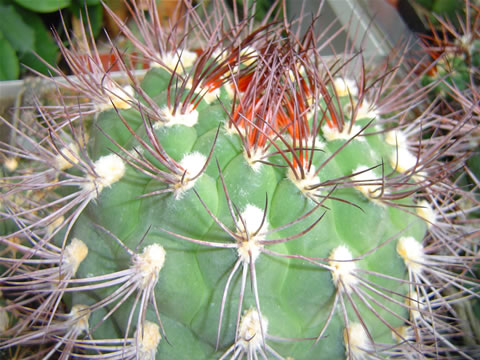
Gymn. pflanzii var. paraguayense
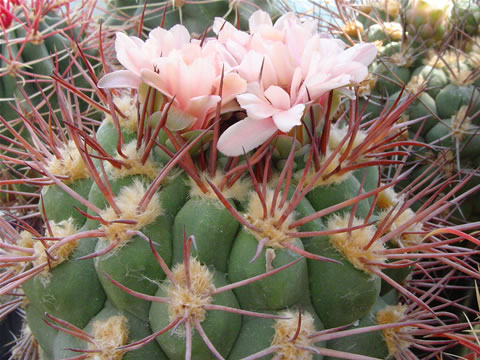
Gymn. pflanzii var. paraguayense
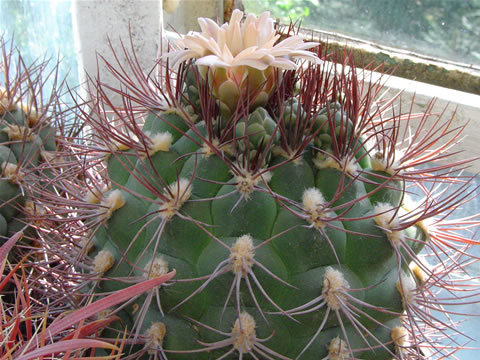
Gymn. pflanzii var. paraguayense GM 437
Gymn. pflanzii ssp.argentinense (Backbg.) Till & W. Till
Kakteen und andere Sukkulenten 1988
Basionym: Gymn. marquezii var. argentinense Backbg.
Kakteenlexikon 1966.
Liší se od typu vetšinou tmavě šedozelenou barvou epidermis, většinou dvojnásobně velkými vlnitými areolami, a světlejšími, většitou krémově bílými květy s kratšími okvětními lístky s tupými vrcholky. Trny jsou jen málo ohnuté, odstávající, v mládí černohnědé.
Domovina: Argentina, více než 300 km od typu, jihovýchodní Salta, od Santa Clara po Lumbreras, a Joaquin V. Gonzales u Rio Pilcomayo; provincie Santiago del Estero, u Tala Yaco.
Backebergův popis, Kakteenlexikon 169, 1966:
Tělo tmavě listově zelené, epidermis jemně zrnitá, jizvovitá; žebra 8 (- 10), na základně až přes 3,5 cm silná, široká.
Suché trny popelavě šedé, mokré kaštanově hnědé, nebo zpočátku nahoře tmavší, dole načervenalé; okrajové trny 7 – 9 (- 12), bočně ohnuté, až 2,5 cm dlouhé; střední trny 1 – 2 (- 4), více odstávající, stejně dlouhé jako okrajové.
Květy až 5,5 cm v průměru, bílé, jícen světle červený; tyčinky červené, blizna dlouhá, široce rozprostřená, červená.
Firma Karlheinz Uhlig v Rommelshausenu dostala mnoho importů a také naši gymnofilové si jich několik objednali. Květy jsou čistě bílé, široce se otevírající s krátkou trubkou, a purpurově červeným jícnem.
Brigitte a Jörg Piltzovi pozorovali rostliny roku 1976 u Rio Juramento (P 154) v provincii Salta, a v provincii Jujuy (P 240). Tytéž oblasti navštívil belgický gymnofil Jacques Lambert, svůj nález od Rio Juramento označil JL 29. Další nálezy: JO 165 (Josef Odehnal) Juramento, HV 828 San Roque (Hermann Vertongen).
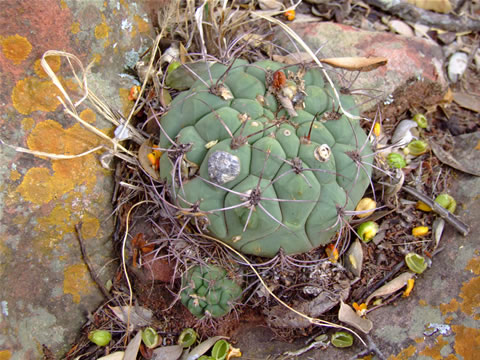
Gymn. pflanzii argentinense Alemania, foto Ch

Gymn. pflanzii ssp. argentinense Alemania, foto Ch
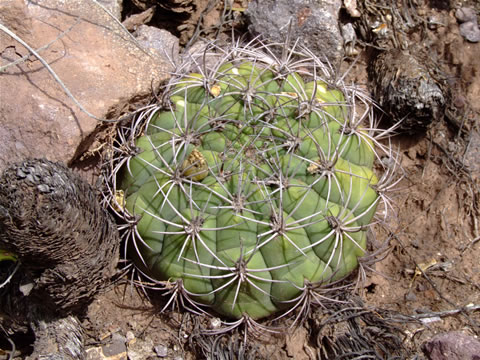
Gymn. pflanzii argentinense Quebrada De Conchas, foto Ch
Gymn. pflanzii – summary:
The taxon had been found at first by Karl Pflanz, the German consul in Villa Montes, who sent the found plants to the Botanic garden in Berlin – Dahlem at the end of July 1923. Prof. Vaupel published the description immediately in 1923 in Zeitschrift für Sukkulentenkunde to the merit of its finder, then prof. Werdermann overcombined the taxon into the genus Gymnocalycium and he published the colour picture in his Blühende Kakteen. Plants had been known only in the Botanic garden in Berlin – Dahlem and in the picture of Werdermann, however, the sowing had not been succesful and so the taxon had not been multiplied and it has been slowly going into the oblivion. Karl Pflanz sent the other data as to the occurence, the specimens had grown in groups with 10 to 30 heads thrust together on the sandy slope on the shores of the river Pilcomayo in Bolivia. The specimens had been light green to yellowgreen, the younger ones had epidermis with reddish tinge. It is possible to add to the description that the throat is not clearly violett but magenta red with strong lilac tinge, fruits are dark red with dark red pulpa.
Cactofils had not practically known the taxon and the situation had been lasting nearly 40 years. Günther Moser from Kufstein had been succesful after many years in initiating again Adolfo Maria Friedrich, living in Asuncion, for collecting plants in Paraguay. Then A.M. Friedrich sent to Günther Moser the consignment of many plants in 1962 which he had collected directly on the shores of the river Pilcomayo along the frontier between Paraguay and Bolivia. Günther Moser had published the finds in his beautiful book „Adolfo Maria Friedrich und sein schönes Paraguay“ even with the photos from the finding places made by A.M. Friedrich. The specimens have nice dull green to yellowgreen epidermis and very contract brownred spines.
The Bolivian botanist prof. Cárdenas made searching and observing abot at the same time. The taxon occurs at Ibipopo near the finding place of the type, and at Cumburate and at Ivo else, the specimens growing in sand reach bigger sizes than the ones growing on rocks. Cárdenas has found on red sandstone at Villa Montes one miniature form with the diameter of the body max. to 7 cm which he has described then as Gymn. marquezii. The taxon has been recognized as the sort at first, in the last work of the Austrian gymnofils (2000) it is mentioned like the synonym of Gymn. pflanzii in the title, then like a miniature form of Gymn. pflanzii in the text.
Dr. Gerd Alois Esser has been another botanist studying the plants in Paraguay. The specimens of Gymn. pflanzii are rich numerous at Teniente Enciso where they have been searched also by A.M. Friedrich about 50 km far at these colony. The specimens have light grass green epidermis, are globular and to 20 cm high. Spines have nice dark red colour which is more striking after watering.. They have flowers salmon pink, orange or whitish, always with dark red throat. Fruit is dark red with dark red pulpa, 3 cm big, bursting laterally. It is the different form of Gymn. pflanzii which was described in the Austrian Gymnocalycium as Gymn. pflanzii var. paraguayense Till & Amerh.
Gymn. pflanzii has been often changed with Gymn. marquezii var. argentinense which was later overcombined to Gymn. pflanzii ssp. argentinense (Backbg.) Till & W. Till in KuaS 1988. Hans Till mentioned here that the different occurence areas and the differences in the habitus and flower details are the reasons and let to get Gymn. pflanzii and Gymn. marquezii as the different taxa. See the notes at this taxon.
The father Alfredo Lau went to the areas for cacti several years after A.M. Friedrich. He has collected several taxa of the relationship and then he has sent the plants to the English botanist John Donald for the professional working. He has rowed all taxa under the main sort Gymn. pflanzii, then without any regard to the differences in the points 1 – 3 mentioned in the introduction here, and he rowed here even Gymn. eytianum which belongs to the subgenus Muscosemineum. Friedrich Ritter, living in Chile at that time, has rowed all taxa with red fruits like the synonyms of Gymn. pflanzii and he has made for Gymn. zegarrae and its relationship new name Gymn. pflanzii var. albipulpa (= with white pulpa), FR 397, it had been sometime offered like Gymn. bolivianum Ritter nom. nud. Some specialists had said that it had been for the sake of the personal contentions of Ritter and Cárdenas, however, we can not find it now. The carriage like this we can see even now.
The taxon and its relations originated from the subtropical areas and it is necessary to adapt also growing to it. Greenhouses are suitable, where the temperature does not go under 15°C, hotbeds are not good. If the plant losts roots, it is hardly possible to make new roots. While the taxa related to Gymn. zegarrae are easy to grow from seeds, Gymn. pflanzii and close relations grown from seeds are the top craft of the gymnogrower, however, it is necessary to have some fortune more. Seeds are germinal even ten years and the succesful sowing of Gymn. pflanzii and Gymn. pflanzii var. paraguayense can be made once in ten years and it is always the reason for the proper celebration. The flowers of Gymn. pflanzii and especially ones of Gymn. pflanzii var. paraguayense belong to the most beautiful experiences of the grower in the greenhouse, the favour of it is rather littler by making millions seeds which grower does not know to do with. The interest for seeds is little for the sake of their reputed sprouting unwillingness. Even after sprouting the seedlings are so small that the grower is not sure long time.
The field numbers of Gymn. pflanzii are not mentioned here, because every collector has marked with the name Gymn. pflanzii various taxa.
Gymn. pflanzii var. paraguayense
A.M. Friedrich is the finder of the taxon, who found it in very difficulty attainable area in 1962. Several nice photos from the finding place are in the book of Günther Moser „Adolfo Maria Friedrich und sein schönes Paraguay“. Especially the family of the Moro Indians if the husband carries the full wheel-barrow with freshly hoed plants of Gymn. pflanzii var. paraguayense and the wife carries the full pail of the plants Gymn. friedrichii var. moserianum, surely prepared for soon sending to Europe. To see it today by so called „protectors“, it will come it to their desperate madness.
Helmut Amerhauser found another finding place 30 years later, about 54 km far of the place of A.M. Friedrich. Dr. Esser has searched also this area – see the notes at Gymn. pflanzii. The Austrian collector Wilhelm Knoll visited the areas in the seventies of the last century and he has marked his find with the field number WO 80 (WO = Wilhelm Knoll + Oswald Klein). The specimens have been offspringing abudantly and have grown together with Gymn. friedrichii var. moserianum. Horst has marked his find from Teniente Enciso like Gymn. pflanzii HU 310. The last finds are numbers of Ludwig Bercht from Holland: LB 2201 La Patria and LB 2202 14 km west of La Patria.
Gymn. pflanzii var. argentinense
It differs from the type with mostly graygreen colour of epidermis, with mostly two times bigger wooly areoles, and with lighter, mostly cream white flowers with shorter perianth leaves with blunt tops. Spines are only little curved, outstanding, blackbrown when young.
Backeberg´s description: Body dark leave green, epidermis gently granular, scarred; ribs 8 (- 10), to over 3,5 cm strong and broad on the base.
Dry spines ashy gray, wet chestnut brown, or upwards darker, downwards reddish at first; marginal spines 7 – 9 (- 12), laterally curved, to 2,5 cm long; centrals 1 – 2 (- 4), more outstanding, length the same like marginals.
Flowers to 5,5 cm in diameter, white, throat light red, stamens red, stigma long, widely spread, red.
The firm of Karlheinz Uhlig in Rommelshausen had got many imported plants and also our gymnofils had ordered several of them. The flowers are clearly white, widely opening with short tube and purplered throat.
Brigitte and Jörg Piltz observed the plants in 1976 at Rio Juramento (P 154) in the province Salta, and in the province Jujuy (P 240). The Belgian gymnofil Jacques Lambert has visited the same areas and he has marked his find JL 29. The other finds: JO 165 (Josef Odehnal) Juramento, HV 828 San Roque (Hermann Vertongen).
